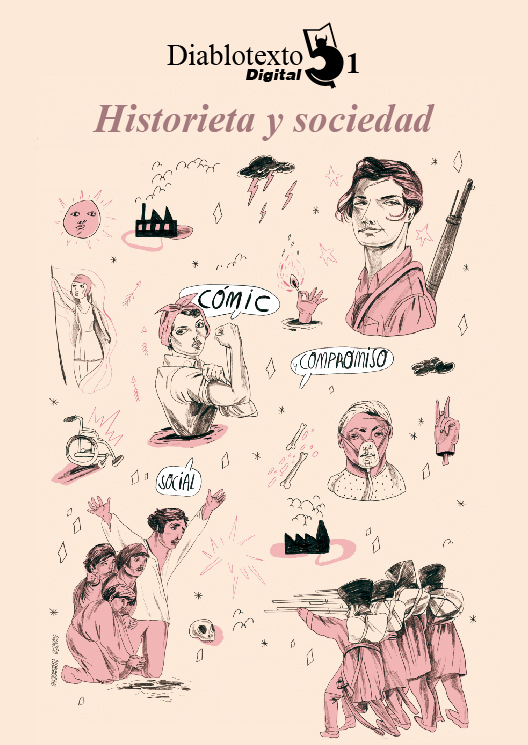The Graphic Report: an Alternative of the Journalistic Commitment. Contextual Representation and Narrative Strategies. Los vagabundos de la chatarra (2014)
DOI:
https://doi.org/10.7203/diablotexto.1.8860Keywords:
Graphic Novel, Semiotics, Iconotext, Chatarra, Journalistic Commitment Abstract
Abstract
In the recent production of graphic novels, the influence of the social context receive a particular and increasing relevancy, both as what the construction of diegesis and the elaboration of the iconotextual aesthetics concerns. Across the denunciation, by Carrión and Sagar, of the precariousness of the illegal ones that survive of the clandestine trade of residues, we aim to explore the specificity of a graphic journalistic writing marked by its heterogeneity and to understand how the traditional narrative and semiotic resources of the iconotextual representation permit to renew the treatment of contextual facts in a hybrid support, between diegesis and referential world.
 Downloads
Downloads
 References
References
Bricco, Elisa. “Le roman graphique et l’Histoire: pour un récit engagé”, Cahiers de Narratologie [En línea], 26 | 2014, 01 de octubre de 2014, [22 de julio de 2015]. URL: http://narratologie.revues.org/6864
Barthes, Roland (1964). “Rhétorique de l’image”, Communications, 4, Recherches sémiologiques, pp. 40-51.
Barthes, Roland (1968). “El efecto de realidad”, Communications, 11, Trad. Beatriz Dorriots, 1972 para la 2a edición de la traducción, pp. 95-101.
Carrión, Jorge; Forniés, Sagar (2015). Barcelona. Los vagabundos de la chatarra. Barcelona: Norma.
Fresnault-Deruelle, Pierre (2011). Hergéologie. Cohérence et cohésion du récit en images dans les aventures de Tintin. Tours: Presses Universitaires François Rabelais, Iconotextes.
Gravett, Paul (2011). “Joe Sacco en Palestine: du témoin à l’historien”. En Viviane Alary y Benoît Mitaine (ed.), Lignes de front: bande dessinée et totalitarisme. Chêne-Bourg: Georg, pp. 245-254.
Groensteen, Thierry (2005). La bande dessinée: une littérature graphique. Paris: Milan.
Helbo, André (1975). Sémiologie de la représentation. Théâtre, télévision, bande dessinée. Bruxelles: Complexe.
Lotman, Youri (1973). “Texte et hors-texte”, en Collectif CHANGE, Transformer, Traduire. Mallarmé: traducteur traduit, 14. Paris: Seghers / Laffont, pp. 33-43.
McLoud, Scott [1992] (2000). L’art invisible. Comprendre la bande dessinée. Trad. Dominique Petitfaux. Paris: Vertige Graphic.
Pernin, Georges (1974). Un monde étrange: la bande dessinée. Paris: Clédor.
Porret, Michel (2009). “La bande dessinée éprouve l’histoire”. En Michel Porret (ed.), Objectif bulles. Bande dessinée et histoire. Chêne-Bourg: Georg, pp. 11-42.
Sacco, Joe (2012). Reportages. Paris: Futuropolis.
Samson, Jacques (2011). “Le sujet de la guerre en bande dessinée”. En Viviane Alary y Benoît Mitaine (ed.), Lignes de front: bande dessinée et totalitarisme. Chêne-Bourg: Georg, pp. 255-268.
Xavier, José-Manuel (2003). La poétique du mouvement suivie du Carnet de l’animateur. Angoulême: Centre National de la Bande Dessinée et de l’Image.
Downloads
Published
How to Cite
-
Abstract870
-
PDF (Español)511
Issue
Section
License
Licencia de reconocimiento de Creative Commons “Reconocimiento - No Comercia l- Sin Obra Derivada
Authors who publish with this journal agree to the following items:
The authors will keep their copyright and guarantee the journal the right of first publication of their work, which will be simultaneously subject to the Creative Commons license that allows third parties to share the work indicating its author and its first publication in the journal. The authors may adopt other non-exclusive license agreements to distribute the version of the published work (e.g., depositing it in an institutional telematic file or publishing it in a monographic volume), with an acknowledgment of its initial publication in this journal. The authors are allowed and encouraged to disseminate their work through the Internet (e.g., in institutional telematic archives or on their website) before and during the submission process, which can produce interesting exchanges and increase citations of the published work. (See Effect of Open Access)




